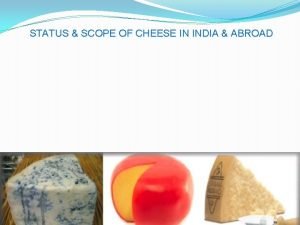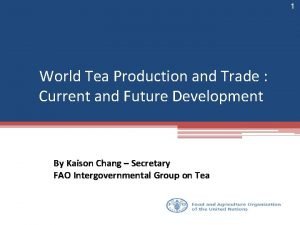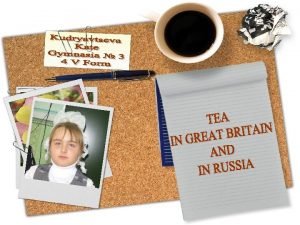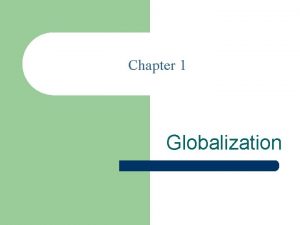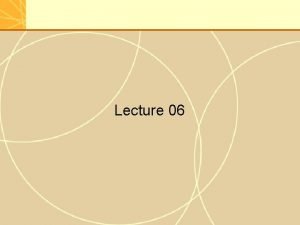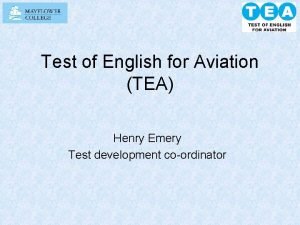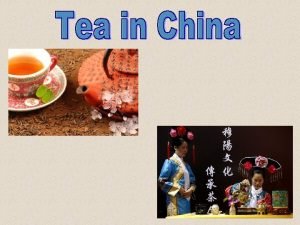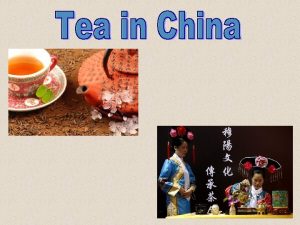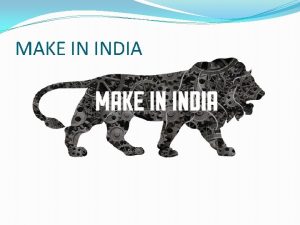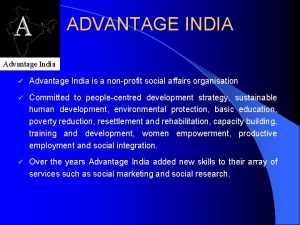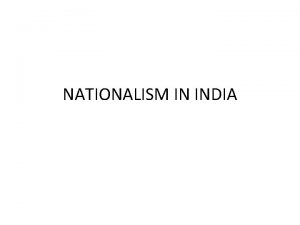tea Tea industry in India 1 WORLD TEA



























- Slides: 27

tea Tea industry in India 1

WORLD TEA SCENARIO 2013 • World Production -- ~4819 million kg o India’s share 1200 m. kg 25% : 2 nd position • Global Area under Tea 3. 69 million hectare o India’s share 0. 56 m. hec 15% : 2 nd position • World Exports – 1865 million kg – Exported % of Total Production: World: 39%: India 18% o India’s Share 219 m. kg 12% : 4 th position • World Consumption -- ~ 4663 million kg o India’s Share 1003 m. kg 22% : 2 nd position

Production, Export and Domestic retention since 1950 Volume of exports hovered around 200 million Kgs over last six decades

TYPE OF TEAS PRODUCED During last 5 years (in M. Kgs) 2009 -10 2010 -11 2011 -12 2012 -13 2013 -14 CTC Orthodox + Green Total 883 856 987 1023 1086 108 111 109 112 123 TOTAL 991 967 1096 1135 1209 9. 92 9. 90 10. 14 % Share of Orthodox + Green 10. 93 11. 49

EXPORTS TO MAJOR COUNTRIES DURING 2013 -14 Top Ten Destinations Volume Value Country M. Kgs. Rs. Cr. Russian Fed 38. 62 639. 91 U. A. E 23. 33 473. 03 Iran 22. 9 603. 85 Pakistan 19. 92 196. 01 United Kingdom 17. 64 338. 13 U. S. A 14. 09 396. 55 Bangladesh 13. 94 131. 42 Kazakhstan 10. 26 207. 69 Germany 7. 77 259. 25 Egypt (ARE) 7. 45 89. 54 Total for top ten 175. 92 3335. 38 Total for > 25 countries 225. 76 4509. 09 %share of top 10 78 % 74 %

Export of Value added Teas over past five years Year Qty (M. Kgs. ) Value (Rs. Crs. ) Value % Share in ( M. US$) total Exports 2009 -10 30. 16 709. 96 149. 01 14. 13 2010 -11 30. 99 775. 25 170. 23 14. 50 2011 -12 23. 96 725. 31 151. 46 11. 18 2012 -13 25. 6 879. 64 161. 59 11. 84 2013 -14 26. 22 974. 73 161. 36 11. 61 Average 27. 386 812. 978 158. 73 12. 65

IMPORT OF TEA INTO INDIA YEAR Price M. Kgs (Rs Crores) (Rs /Kg) CIF Value 2011 -12 19. 21 186. 04 96. 85 2012 -13 21. 90 282. 56 129. 02 2013 -14 19. 23 237. 33 123. 42

EMPLOYMENT PROFILE • Direct Employment 1. 1 Million • 55% are women workers • Dependants of the workers -1. 9 million • The indirect employment is around 3 times the direct employment. • Thus > 4 million people are dependant on tea for their livelihoods • Indirect employment– in allied activities warehousing, transport, farm and factory inputs food grain supply and tea machinery manufacturing and servicing etc. 8

Current Thrust areas The main focus is on maintaining a healthy balance between supply and demand for meeting the domestic demand in full and maintain current level of Exports Thrust Areas: 1. Increasing Production & Productivity through Replanting and extension Planting. 2. Special focus on development of small holdings 3. Quality Assurance through Certification, value addition 4. Market Promotion - domestic and international 5. Plantation Worker’s welfare 6. Integrated R & D - climate change- Pesticide Residue issues 7. Regulatory measures for safeguarding the quality image of Indian teas 9

Challenges • Stagnant Productivity • Increasing Labour Costs- shortage & absenteeism • Adverse effect of climate change &increasing cost of Pest Control • Small Tea Growers- quality risks • Quality related regulatory issues • R&D – to keep pace with the new challenges • Stagnant export –need for value addition, product and market diversification

Stagnant Productivity Declining yield - owing to aging of tea bushes. crop and revenue loss during gestation period. • A comprehensive survey of all big tea gardens carried out – 148305 ha 37% of the bushes are >50 years of age • It is targeted to renovate 47, 000 ha during XII Plan period ending 2017

Labour related issues Increasing Labour cost, shortage and absenteeism • Tie up with IITs for development of mechanical aids for improving the working efficiency & reduce drudgery. • Tea Industry continues to bear the social cost rendering Indian teas uncompetitive in the international markets.

COST OF PRODUCTION • 70% of Co. P comprises of Fixed Costs • Price realization at the farm gate level is not keeping pace with inflationary rise in the cost of inputs • High Social Welfare cost • High cost would be largely mitigated through improvement of yields. 13

Adverse effect of climate change & increasing cost of Pest Control Prolonged droughts, incessant pest attacks adversely impacting productivity and cost of production • Cost effective pest management, harmonization of Pesticide residue issues • A Pesticide Code has been developed and notified. It will come into force with effect from 1 st Septemebr 2014 • Launched a Sustainability Tea programme “trustea” for ensuring quality assurance and compliance with food safety standards

SUSTAINABILITY ISSUES • Rainwater Harvesting • Recharging Groundwater • Effluent & Waste Management • Afforestation & Micro-Climate Management • Utilisation of Renewable Energy resources • Safe Use of Pesticides & Adoption of Sustainable Field Practices – • Trustea Code • Plant Protection Code (Version-2 in Tea Board website)

PLANT PROTECTION CODE • The Tea Board of India has implemented a 'Plant Protection Code' (PPC) for tea production. • The PPC is a best practice guide to sustainable and safe tea production. • PPC covers : o Use of only approved Plant Protection Formulations (PPFs) by Central Insecticide Board, Go. I o Adherence to MRLs for pesticides laid down by the FSSAI

SUSTAINABILITY - INITIATIVES Ground water recharging RAIN WATE COLLECTION 17

Afforestation Rain Water Harvesting Reservoir

Small Tea Growers- development Mushrooming of small holdings and Bought Leaf Factories (BLF) Green leaf price volatility –reasonable price not being realised due to indifferent quality • A New Directorate with adequate manpower set up in April 2013. • Opened field offices for closer interface with the growers and BLFs. • Enumeration of growers- smart cards • Better extension services for adopting GAP & GMPs • Improvement of quality & value addition • Price Sharing formula-for ensuring reasonable price for green leaf

Quality related regulatory issues • Thrust on compliance with GMP and quality certifications such as ISO 22000/HACCP etc • e-auction – Online auction of tea - moving towards Pan India auction • Tea Councils of India for Mandatory checking of tea exports & imports – to ensure compliance with the FSSAI norms

R&D–to keep pace with the new challenges • TRIs have initiated work on – the impact, vulnerability and adaptation of tea to climate change. – Irrigation, water harvesting and conservation – Mechanisation especially for harvesting – Non pesticidal control of pests /Organic tea – Biotechnological studies for identifying potent genes responsible for tolerance to drought and pest attacks.

Stagnant export markets Need for Value addition , product & market diversification • “Brand India” promotion in targeted markets • 1. Extensive promotion of India Tea – 2. Engagement with the local trading community – 3. Consumer-oriented promotion – 4. Utilisation of Social Media – 5. Focus on export of value-added teas • Promotion of Indian tea brands having 100% India tea packed and exported from India. • Setting up of Specialty Tea Factories/value additionpackaging/blending/tea bagging • Setting up of Integrated Tea Parks for common

MARKETING : DOMESTIC • Domestic consumption is lagging at 733 gms per capita – lower than many countries like UK, Ireland, Pakistan, etc • Domestic promotion is needed to attract Youth & Young Professionals with high disposable income and aspirational life style • Industry & Tea Board jointly conducting B 2 C promotion programme – Tea Carnival : “Chai Ho Jaye” 23

INDIAN TEA CARNIVAL : CHAI HO JAYE . • India's first ever Tea Carnival – Chai Ho Jaye – was organised in collaboration with Tea Board of India in Gurgaon and Ahmedabad. • More cities planned to be covered.

INDIAN TEA CARNIVAL – CHAI HO JAYE

INDIAN TEA CARNIVAL : CHAI HO JAYE

Thank you
 Distribution of cotton wool and silk industries
Distribution of cotton wool and silk industries Hvac industry in india
Hvac industry in india Madras consultancy group
Madras consultancy group Amul cheese
Amul cheese World tea consumption
World tea consumption Tea is popular many people in the world
Tea is popular many people in the world World music india
World music india British in india ap world history
British in india ap world history What is the world's largest industry
What is the world's largest industry The empire era tourism
The empire era tourism Primate traits
Primate traits New world to old world columbian exchange
New world to old world columbian exchange Real world vs digital world
Real world vs digital world World of forms
World of forms Ap world history chapter 25 africa and the atlantic world
Ap world history chapter 25 africa and the atlantic world The changing world output and world trade picture
The changing world output and world trade picture Dangerous world tour history world tour - hockenheimring
Dangerous world tour history world tour - hockenheimring An elementary school classroom in a slum theme
An elementary school classroom in a slum theme Belled flowery tyrolese valley
Belled flowery tyrolese valley Unit 9 english in the world looking back
Unit 9 english in the world looking back The changing world output and world trade picture
The changing world output and world trade picture Tea act propaganda poster
Tea act propaganda poster Bucolaj istarski
Bucolaj istarski Their eyes were watching god chapter 10
Their eyes were watching god chapter 10 Their eyes are watching god chapter 13
Their eyes are watching god chapter 13 Revolutionary war diorama
Revolutionary war diorama Oral administration staar 2020
Oral administration staar 2020 Tea test aviation
Tea test aviation



